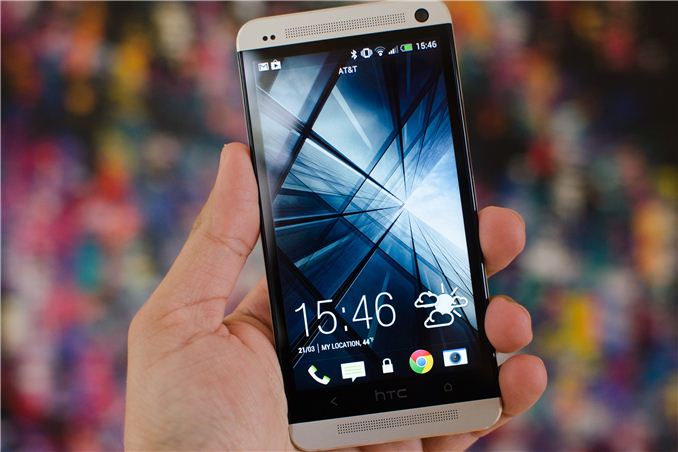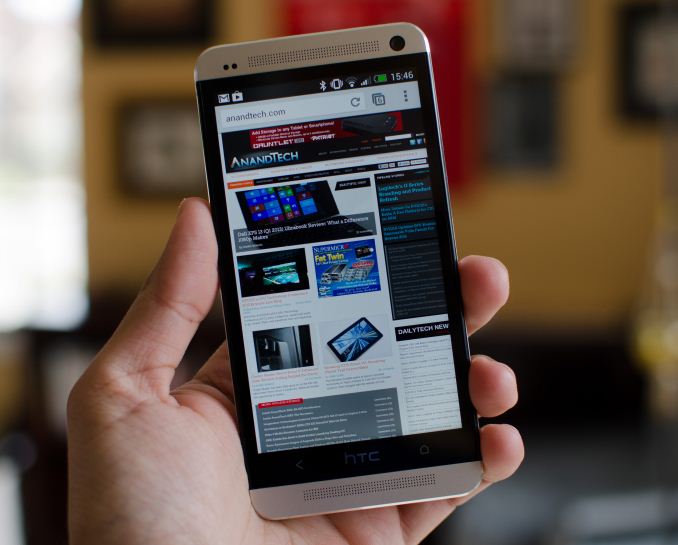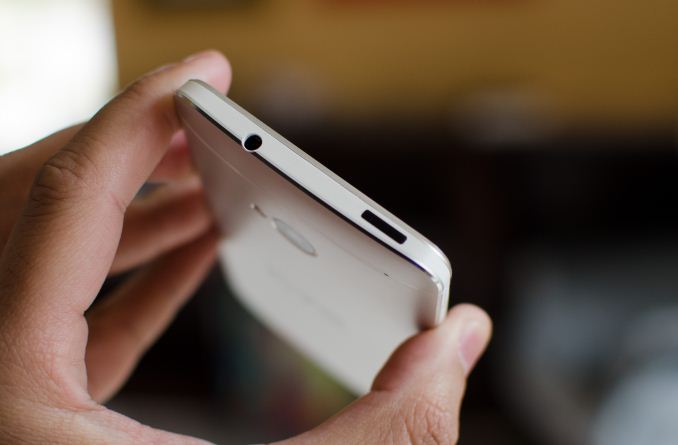The HTC One: A Remarkable Device, Anand’s mini Review
by Anand Lal Shimpi on March 21, 2013 4:49 PM EST- Posted in
- Smartphones
- HTC
- Mobile
- HTC One

For the past week and a half our own Brian Klug has been hard at work on his review of HTC’s new flagship smartphone, the One. These things take time and Brian’s review, at least what I’ve seen of it, is nothing short of the reference piece we’ve come to expect from him.
In the same period of time I’ve been playing around with a retail HTC One and felt compelled to share my thoughts on the device. It’s rare that I’m so moved by a device to chime in outside of the official review, but the One is a definite exception. By no means is this a full review, and I defer to Brian for the complete story on the One - something we should be getting here in the not too distant future.
I’m not a financial analyst, but HTC hasn’t been doing all that well over the past few quarters. There’s a general feeling that the aptly named One is HTC’s last chance at survival. Good product doesn’t always translate into market dominance, but it’s a necessary component when you’re an underdog. Luckily for HTC, the One is great.
Design
Over the past two years HTC has really come into its own as far as design is concerned. The difference between the HTC One X and the plethora of flagships that came before it was remarkable. Moving to the One, the difference is just as striking.
I don’t seem to mind plastic phones as much as everyone else, but the One is in an appreciably different league compared to its peers. It’s the type of device that you just want to look at and touch. Given how much you do end up looking at and touching your smartphone, HTC’s efforts here seem well placed.
The One looks and feels great. The proportions are a little awkward in my hands, but I fully concede that’s going to vary from person to person. Despite the heavy use of aluminum, I don't feel overly worried about scratching/damaging the finish.
The challenge with any smartphone is to build something that looks distinct in a sea of black rectangles on a wall in a store. With the One (and arguably the One X before it), HTC does a good job of balancing the need to be seen with the need to be subtle. Elegant is the right word here.
While I’m sure there will be comparisons to the iPhone, the fact of the matter is that the design cycle on these smartphones falls somewhere in the 12 - 24 month range. With something as sophisticated as the One, you’re looking at the longer end of that spectrum. For what it’s worth, if I had to estimate I’d say design work on the One probably started before the iPhone 4S came out.
| Smartphone Spec Comparison | ||||||
| Apple iPhone 5 | HTC One | Samsung Galaxy S 3 | Samsung Galaxy S 4 | |||
| SoC | Apple A6 1.3GHz | Snapdragon 600 1.7GHz | Snapdragon S4 1.5GHz | Exynos 5 Octa (1.6/1.2GHz) or Snapdragon 600 1.9GHz | ||
| DRAM/NAND/Expansion | 1GB LPDDR2, 16/32/64GB NAND | 2GB LPDDR2, 32/64GB NAND | 2GB LPDDR2, 16/32GB NAND, microSD | 2GB LPDDR3, 16/32/64GB NAND, microSD | ||
| Display | 4.0-inch 1136 x 640 LCD | 4.7-inch SLCD3 1080p, 468 ppi | 4.8-inch Super AMOLED 720p, 306 ppi | 5-inch Super AMOLED 1080p, 441 ppi | ||
| Network | 2G / 3G / 4G LTE Cat 3 | 2G / 3G / 4G LTE Cat 3 | 2G / 3G / 4G LTE Cat 3 | 2G / 3G / 4G LTE Cat 3 (depending on region) | ||
| Dimensions | 123.8mm x 58.6mm x 7.6mm | 137.4mm x 68.2mm x 4mm - 9.3mm | 136.6mm x 70.6mm 8.6mm | 136.6mm x 69.8mm x 7.9mm | ||
| Weight | 112g | 143g | 133g | 130g | ||
| Rear Camera | 8MP | 4MP w/ 2µm pixels | 8MP | 13MP | ||
| Front Camera | 1.2MP | 2.1MP | 1.9MP | 2MP | ||
| Battery | Internal 5.45 Wh | Internal 8.74 Wh | Removable 7.98 Wh | Removable 9.88 Wh | ||
| OS | iOS 6.1.2 | Android 4.1.2 | Android 4.1.2 | Android 4.2.2 | ||
| Connectivity | 802.11a/b/g/n, BT 4.0, USB 2.0, GPS/GNSS | 802.11ac/a/b/g/n + BT 4.0, USB2.0, GPS/GNSS, IR LED, MHL, DLNA, NFC | 802.11a/b/g/n, BT 4.0, USB 2.0, NFC, GPS/GNSS, MHL | 802.11a/b/g/n/ac (HT80) + BT 4.0, USB 2.0 NFC, GPS/GNSS, IR LED, MHL 2.0 | ||












434 Comments
View All Comments
DEECEE - Friday, March 29, 2013 - link
Really, Razr Maxx lasts longer and still has replaceable battery...phillyry - Sunday, March 24, 2013 - link
Or when they fell out when you dropped the phone!CeriseCogburn - Monday, March 25, 2013 - link
The back cover coming off and the battery spewing across the floor, (the sim card(s) * or SD lesser so) ABSORB THE SHOCK of the floor strike and spread the force across a largeer area of the phone, SAVING IT FROM DAMAGE, DUMMY.So while you're all about your brick shattering or taking a huge whomp on it's now bent forever scratched metal edge and cracked screen, other love the convenience and the SHOCK ABSORBER function.
Thank you, this has been a we love Mr Wizard lesson.
DEECEE - Friday, March 29, 2013 - link
For SD cards, maybe, you can pay to get the 64GB model and think you will never have to worry about it, but Bill Gates also famously stated you will never need more than 640KB of RAM back in the DOS dates. But batteries, really, the chances for a failed battery due to abuse, power surge, or poor quality control is high, even for Apple, why leave it to chance. The issue is not having to carry a spare, the issue is how much hassle and cost it is to replace a failed battery.The same in general applies to a SD card, you may never use it, but why live in fear of running out of storage?
nerd1 - Thursday, March 21, 2013 - link
Sealed battery, non-expandable battery, 4MP camera will be deal breakers for many.The 'Ultrapixel' is just marketing gimmick for low resolution sensor. Yes, it will be better than SMALL low-MP sensors but I doubt they are any better than high-MP sensor with same size. 36MP D800 is almost as good as any low-MP DSLRs with the same sensor size.
extide - Thursday, March 21, 2013 - link
ALl cell phones use the same sensor size, and Anand said right in this review it has better low light performance than any other cell phone camera he has used. Pretty much refutes both your points right there.nerd1 - Thursday, March 21, 2013 - link
The total area of sensor remains unchanged whether you divide them by 4M or 8M. Low MP sensor surely look better in its native resolution, but it won't differ much from the DOWNSAMPLED image from high-MP sensor.metafor - Thursday, March 21, 2013 - link
Like all things, that depends on where in the "pixel size" spectrum you are. At the sizes of the D800 vs 5dM3, for instance, the ability of a single pixel of the D800 to capture light is actually bound by the optics at that point, because the pixels are already big enough.Contrast this with a 1.1um pixel and the picture changes entirely (heh). 1.1um is barely 1.5 wavelength of red light. Attenuation becomes pretty bad at that point and the optics of a wide lens itself becomes a problem due to how deep the pixel is compared to its width.
Think of it this way: 1.1um is abysmal when it comes to light attenuation. As you get to larger and larger pixels, you start getting diminishing returns on how much better light attenuates. At the D800 level, making the pixels larger won't really help that much.
s44 - Friday, March 22, 2013 - link
Read Brian's article. All sensors are *not* the same size.vulcz - Thursday, March 21, 2013 - link
You think Ultrapixel is a gimmick? Wait till you see Samsung's array of S-Stuff.